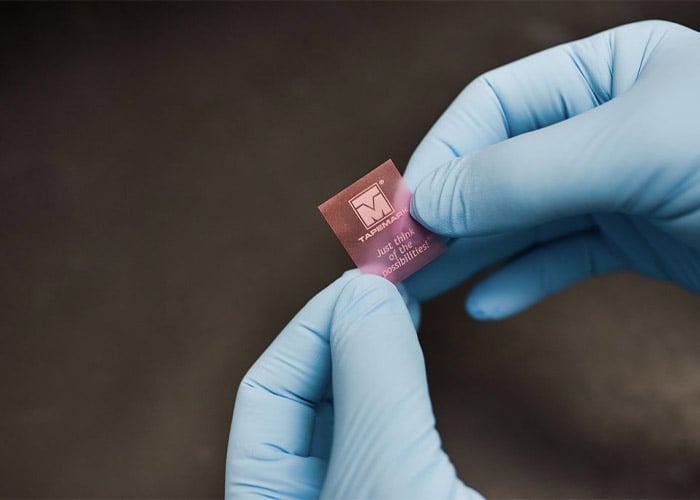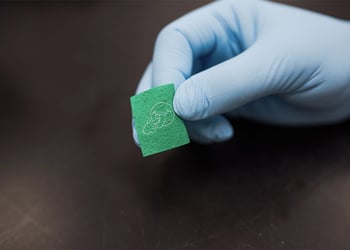Oral Thin Films (OTFs) are strips made with mainly water-soluble polymers, so they dissolve in saliva, typically in less than a minute. While that may sound exotic, if you’ve ever used breath-freshening strips, you have experienced this technology first-hand. The confectionary and oral care industries were the first to capitalize on OTFs. But the pharmaceutical and wellness industries are increasingly exploring the use of therapeutic OTFs, and the market is expected to grow quickly.
In addition to water-soluble polymers, oral thin films contain water, stabilizers to hold components in place, flavorants, active ingredients, and, depending on the film, plasticizers, saliva stimulants, and colorants.

ADVANTAGES OF ORAL THIN FILMS
As OTFs are designed to dissolve in the mouth, they are far less invasive and uncomfortable than injections. They are also advantageous for those who have difficulty chewing or swallowing pills. In fact, OTFs have been shown to dramatically improve compliance among young children as well as patients with Central Nervous System (CNS) conditions that make chewing and swallowing difficult. OTFs can be taken without water, so they’re also more convenient for treatment on the go.
While the active ingredients contained in some therapeutic OTFs are absorbed through the gastrointestinal system, much like a tablet, other OTFs are designed so active ingredients enter the bloodstream more quickly, through the lining of the cheeks and lips. In addition to faster absorption, when drug delivery can bypass the GI tract, there’s less waste of active ingredients, and patients usually experience fewer side effects.
OTFs also have a few advantages for drug manufacturers — the strips can be produced quickly and efficiently through a relatively simple mixing and casting process. Furthermore, introducing a new OTF to the market extends market exclusivity by three years. Drugs with patents that will expire in the next few years may be prime candidates for OTF delivery.
THE CURRENT AND FUTURE ORAL THIN FILMS MARKET
Because of their many benefits over pills, beginning in the 1970s, OTF manufacturers have been adding more and more products to the market. In addition to oral care and nutritional supplement films, OTFs are now used to treat a wide variety of conditions:
- Migraines

- Nausea
- Psychiatric disorders
- ADHD
- Pain
- Cold symptoms
- Opioid addiction
- Digestive issues
- CNS disorders
OTFs are currently in development to include the following active ingredients:
- Montelukast for the treatment of dementia, asthma, and allergies
- Insulin for the management of diabetes
- Rizatriptan to prevent and treat migraines
- Testosterone for the treatment of male hypogonadism
- Various vaccination formulas to combat rotavirus and other contagious diseases
WHICH DRUGS CAN ORAL THIN FILMS DELIVER?
Active ingredients must either be able to be absorbed into the bloodstream through the tissues inside the mouth or pass through the GI tract intact for OTF delivery to be effective. Therefore, most OTFs manufactured today contain small-molecule, water-soluble drugs, which are more readily absorbed. However, many OTF manufacturers are developing technologies that may be able to facilitate the delivery of larger molecule drugs as well as drugs that are water-insoluble.
At present, the Active Pharmaceutical Ingredients (APIs) that are most suitable for OTF delivery have the following properties:
- Are highly potent, and therefore effective at a low dose
- Don’t cause an unpleasant feeling or taste in the mouth
- Have a low molecular weight
- Are stable and soluble in saliva
TYPES OF ORAL THIN FILMS
Although OTFs can be categorized by the manufacturing process involved, they are often identified by where they are placed in the mouth, and how they deliver APIs.
BUCCAL FILMS
Buccal films are designed to stick to the inside of the cheek or lip. Once in place, they will release APIs slowly across the mucous membrane and into the bloodstream until the film is dissolved. Buccal films have the tremendous advantage of bypassing the digestive system, so they cause fewer side effects and are fast-acting.
SUBLINGUAL FILMS
Sublingual films are designed to be placed under the tongue where they will disintegrate in the mouth. Sublingual films do not adhere to mouth tissues to deliver APIs into the bloodstream — they release APIs in saliva, where they are ultimately absorbed in the GI tract.
There are two subcategories of sublingual films. In some sublingual films, known as orally dissolving films, APIs will be partially absorbed in the mouth before the majority of absorption occurs in the GI tract. In orally disintegrating films, all absorption will occur in the GI tract. The subtle difference between the two is determined by the water solubility of the APIs.
IMPORTANT THINGS TO CONSIDER WHEN DESIGNING AN ORAL THIN FILM
Once an OTF has been designed, the manufacturing process is simpler than what’s required to produce most tablets and capsules. However, the initial design of an OTF is often more complex. CDMOs like Tapemark must consider the size and thickness of the film, viscosity, flexibility, strength, as well as the ratio of drugs to polymers. Films must also be palatable, so the taste, feel, and appearance should not be overlooked.
HOW TO CREATE AN ORAL THIN FILM WITH A CDMO
Very few CDMOs have the facilities and the expertise to bring a new OTF from development to commercialization. Tapemark remains the industry leader in OTF drug delivery, with 15 years of experience converting and packaging soluble film. Thanks to its state-of-the-art 150,000 square-foot facility, Tapemark can produce even the most complex multi-layer films. Tapemark also has the craftsmen, artists, and experts needed to take your project from infancy all the way to market.

